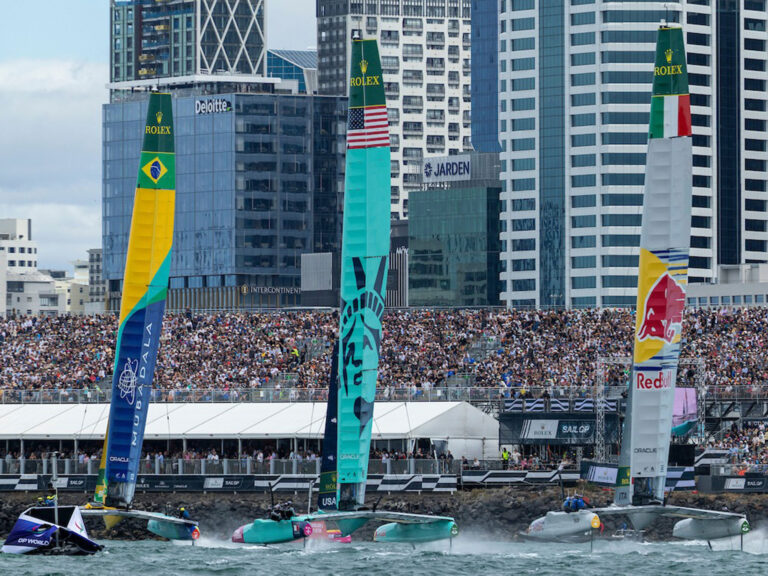pixel review
Bruce Kirby is at it again. The 76-year-old former Olympic sailor, International 14 champ, and raceboat designer has always had a thing about light and sound designs, notably his international success stories, the Laser and the Sonar. Now comes the Pixel, named for one of those dots of color on your computer screen. Kirby says the 13’8″ doublehander is his 15th dinghy design. The Pixel is a light, stable transition dinghy for youth sailors learning about jibs and symmetric spinnakers when they graduate from Optimists or other beginning boats. It also aims to be a boat on the recreational track, for kids not so fired up about racing or sailing solo. Kirby’s target crewweight is 200 to 250 pounds, so it should fit for kids who aren’t ready for more powered-up dinghies like the Laser and Club 420. I went for a sail with Lightning champ Jim Crane on one of four fiberglass and epoxy prototypes built in China for Nearwater Boats (Kirby and partner Wes Oliver). Considering that the wind was light, maybe 4 to 8 knots, and that we were 100 pounds over the target weight, we had a fun sail. The helm balanced easily, and the boat accelerated well in puffs, moving nicely through the chop. The bottom is flat so a little heel going over a bigger wave didn’t seem like a bad idea. The side decks were wide enough for comfortable hiking, and at its windiest, maybe 9 knots, we both were on the rail. I imagine two lighter youth sailors would’ve been sitting together on the rail in 6 or 7 knots of breeze, hiking comfortably in 8 to 12, and getting a good workout when the wind is over that. We set the spinnaker-the first time Kirby had had one up-and had some pleasant little scoots on a few small waves. I think the Pixel would plane easily with a modest amount of wind. It did for Crane’s brother Bill, who sailed the boat without the spinnaker in 20-plus and found that it planed upwind. Even without a trapeze, the boat has enough horsepower. Sailing in light winds as heavy adults, we could’ve used more sail area, but that means it’s probably about right for lighter sailors. Besides being relatively quick, there are other attributes worth noting: The double bottom and the shape of the side tanks makes lounging on the floor of the boat as comfortable as on the side, which for rec sailing is a plus. In combination with an open transom, these design features should make the Pixel easy to self rescue after a capsize. Even better, the boat is extremely stable to start with and has several good anti-turtling details including a sealed (carbon) mast, foam in the top of the mainsail, and inboard cutouts in the sidetanks to make it less stable upside down. I have to confess, due to the raw weather for our test sail, we saved the capsize test for another day. One smart feature of the Pixel related to its stability is its open bow, which makes it easy to step aboard from the float. While rigging the topping lift, Jim Crane stood in front of the mast and had no concern that the boat would flip the way many dinghies would. The absence of a foredeck kept his center of gravity low, and the light carbon spar couldn’t have hurt. Other factors contributing to stability are the flat bottom, relatively hard chines, beamy waterlines, and wide transom. In keeping with this, we noticed that a hard hike was needed to effectively roll tack the boat. The original idea of the Pixel came from Kirby’s partner, Oliver, who says the time has come for a new, modern dinghy that can teach all the basics of spinnaker sailing to lightweight sailors. He also thinks there may be a larger market for the boat, but his focus at the moment is entirely on sailing programs with transitioning sailors. Oliver wants to keep the price at $6,000 or less, and hence the construction in China. At press time in December, a fifth prototype was underway with a few modifications, such as two foam stringers to minimize flexing in the bow sections, and carbon spars (the Pixel’s first spars were built in New England). Oliver intends to deliver complete glass/epoxy boats, direct from the builder, including sails by Neil Pryde of Hong Kong. Production boats should be available for spring delivery. Pixel LOA 13′ 9″ LWL 12′ 6″ Beam 5′ 6″ Disp. 185 lbs. (hull) 220 lbs. (all-up) Sail area 94 sq ft. (upwind) Price $5,950 Nearwater Boats, LLC 203-855-8923





